Trajal Harrell. Sister or He Buried the Body
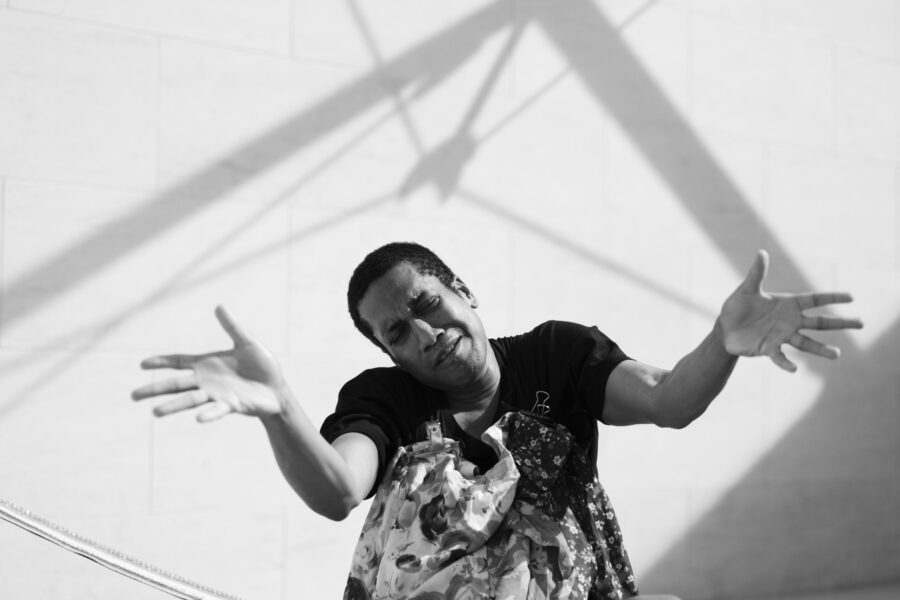 On a pleasant summer afternoon in Luxemburg, I experienced the world premiere of Trajal Harrell’s performance at the naturally lit Great hall of Mudam—sitting on a pillow in close proximity to the artist.
On a pleasant summer afternoon in Luxemburg, I experienced the world premiere of Trajal Harrell’s performance at the naturally lit Great hall of Mudam—sitting on a pillow in close proximity to the artist.
Between fantastical origins and the truth of fantasies, Trajal Harrell’s body draws out a pathway which departs from Haitian voodoo to arrive in post-Hiroshima Japan, during which combinations unveil the multiple layers that make up the history of dance.
I came back to see the performance again the day after, and consequentially I had the chance to be in a conversation with Trajal and Joel Valabrega—curator of the performance and public programmes at the museum—in front of a couple of soft drinks at the museum’s café.
Martina Alemani: What is the relationship between the music you chose and your performance?
Trajal Harrell: I have to talk about how the piece evolved, because originally it was supposed to go to Gwangju Biennial in 2020. Then it was moved to 2021, so I did my first draft in September 2020, and the first idea was that I was going to work with all female vocalists. I was working on two ideas: one was that Tatsumi Hijikata’s dead sister was dancing through his body, and then maybe also that the sister was Katherine Dunham. Dunham was an African American dancer and choreographer who had done a lot of research in Haitian Vodun and now it seems that maybe she had an influence on the evolution of butoh. The sister’s story is that when Hijikata was a little boy and there was a war, his sister left home and he mourned her forever. He loved her very much and went to look for her in the city where he saw that she was made up like a prostitute. So, in general I have been working with this idea of how to give space to people who aren’t represented in the theater normally, in the same way that butoh had sought to represent beggars or drug addicts, junkies, prostitutes, people that are sick, the weak, lame, and those vulnerable.
So, the first iteration was to work with these female voices, and the lyrics that they were singing about, like Tracy Chapman, Joni Mitchell. And then the next iteration, which was not so long, I wanted to get away from the lyrics. I didn’t want this heavy layer on it. I continued with just the movements performed as hand dances. I chose very rhythmic pieces—some piano pieces, some jazz pieces; but I didn’t find them very strong. Then somehow I came back to the lyrics, and I came back to very different aspects of these songs. Some have a kind of lament for mourning, like the first piece Sweet In The Morning, which has a very strong sense of place, of time. You can hear the moan from the voices, they say “sweet in the morning” but the song is not sweet. This was something I thought that could somehow get at the layer of the lost sister.
I just kept going to the songs that I have on my computer. I tried different things and sometimes something works. It has to work not only intellectually, but also physically with me. I really have to find a connection with dance. And then it is just a matter of attitude. There is no formula. I wanted Jezebel in the end, but I struggled with that for a long time. Somehow, I find it taboo, but at the same time I keep doing it because I like it, I like her so much! I also like the idea that in America, Jezebel is a woman who is trashy, a slut, an unwanted woman disgraced by society. Sade sings trying to give her a space and she deserves a space in our society as well. I really wanted to connect her to the sister.
And the blues, I wanted something that was bluesy, like Why Don’t You Do Right by Lil’ Green. I was trying to find different layers that the viewer could relate to—different landscapes. I didn’t want them to become representational, but I wanted people to relate them to some sort of female conditioning, an abstraction of the sister that we can feel for her. All of this is through the music, but also the costumes, the installation…
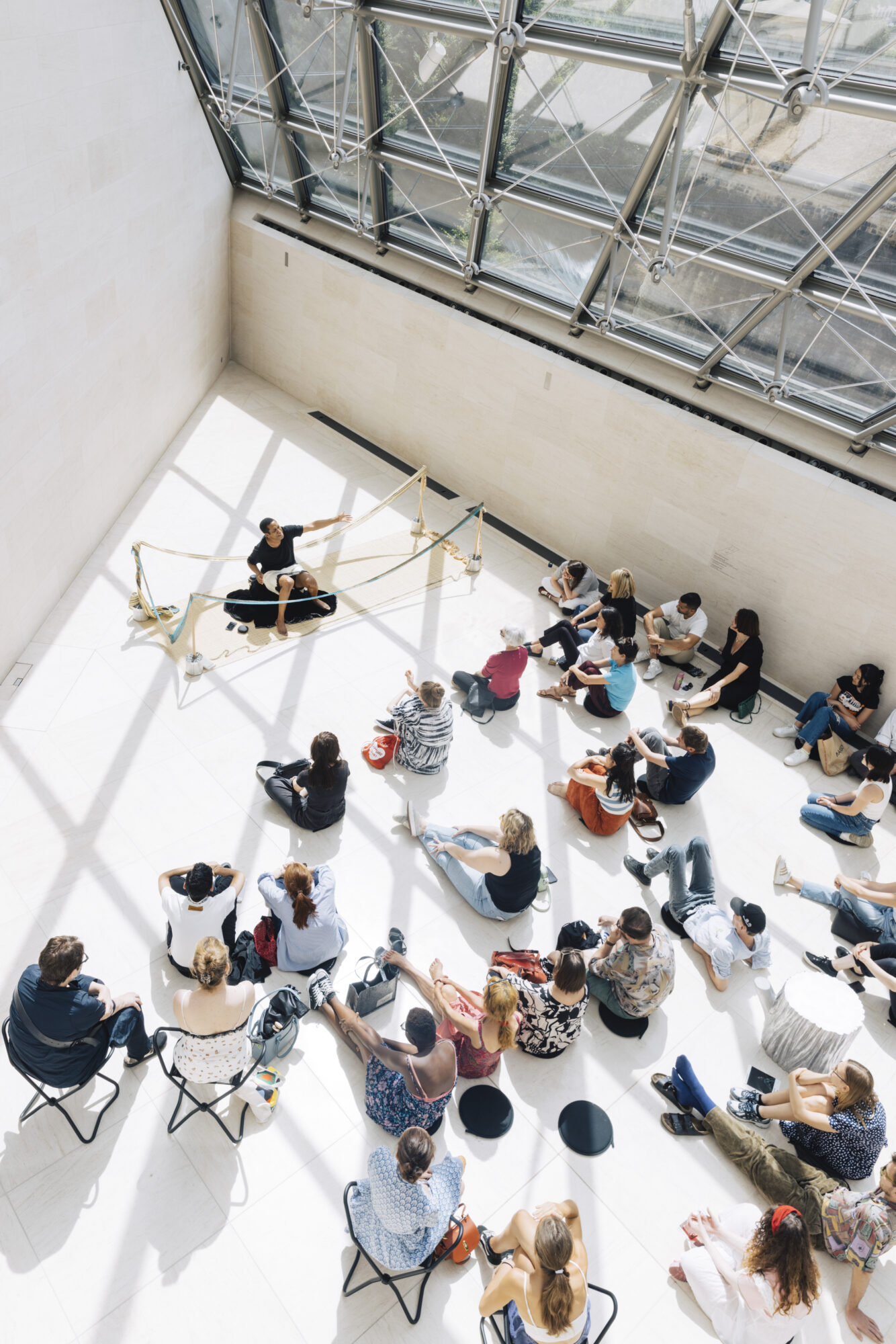
MA: How does the choices of costumes come about?
TH: It’s fun, I have a selection, I like many pieces, there is not only one costume. Each time I can wear something different. But again, I wanted something that was out of time and place, an abstraction, that had maybe a vogue reference and of course a reference to the sister, which is related to the female, so it’s all dresses or skirts. I tried to find something old, but that could also be contemporary. There are layers and some layers can only be worn or taken off at the end, before the last piece. Usually, I take something off. There is also the black t-shirt: since it is a hand dance, I wanted a background for the hands—visually. If there is too much color or there are prints in the background, the hands get lost.
MA: Why a hand dance?
TH: I think there are two reasons: the biggest one is that I really wanted to make a dance that I could dance when I will be 70. I wanted to do something that would allow me to not have the ease of movement that I have now, moving through space with my legs. I had made a solo piece, Dancer of the Year, and a lot of people think that it is my signature piece. But it has a limitation: I’m very happy to dance it to the end, but I know that at some point I won’t be able to dance it anymore. That’s why, by contrast, I wanted to make something that I could dance maybe even at 80 years old. That is a first consideration, really.
And the second is that I have been working on the hands for a long time, and these gestures make a dance of the hands—which is a face dance also. I work a lot with facial expressions and hands, and I somehow wanted to finally narrow it down to these. It is also a very ancient form of dancing. You see it in tapestries, in paintings, in dancers sitting in courtyards or in a royal court.
Also, I wanted to change the prospective of the viewer: get away from everyone sitting in a formal audience and watching someone higher up on the stage.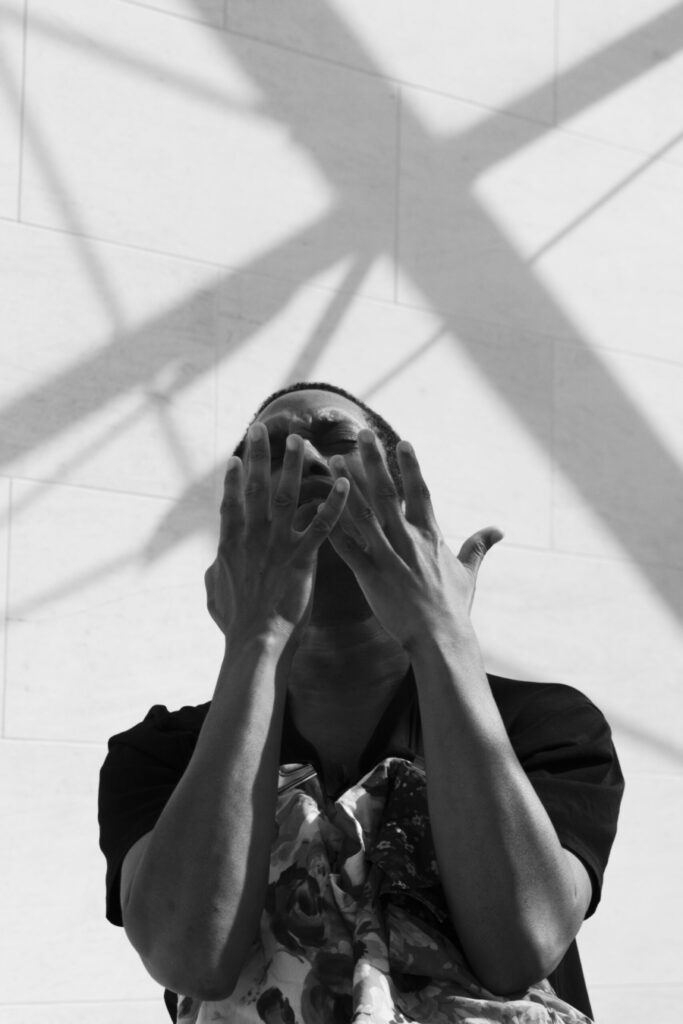
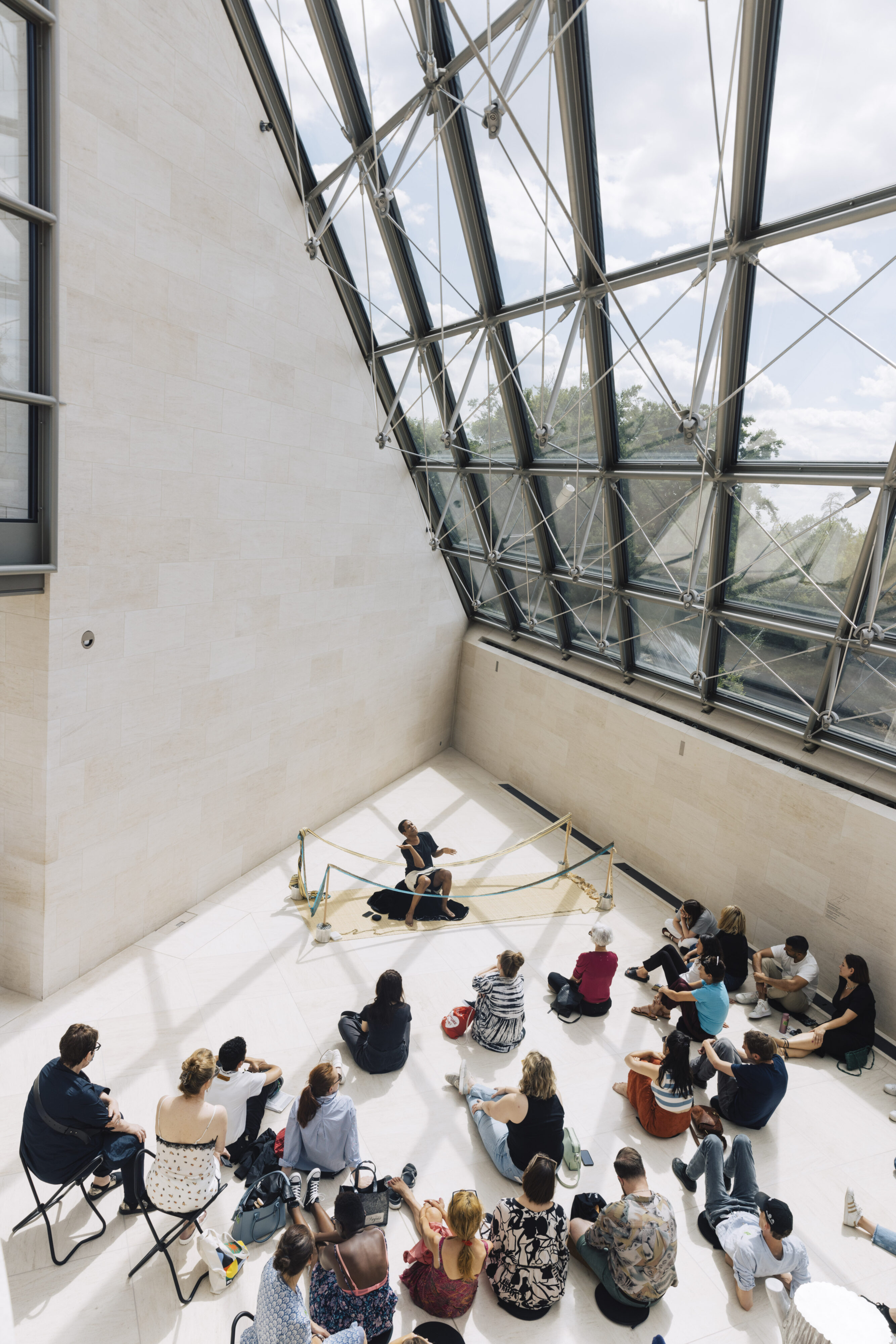 MA: How do you prepare to a performance?
MA: How do you prepare to a performance?
TH: I usually come to the performance space two hours before the time. I have to eat three hours before. Here it was very difficult because I had breakfast at 9 a.m. and I was not ready to eat at 12 p.m. because the start of the performance was at 3 p.m. So instead, I had a little rehearsal by eating two hours before.
Also, I try to normalize, I don’t sit in a corner, I have my warm-up that starts an hour before the show. Meanwhile, I talk to people, I try to stay in reality and do what I have to do. That calms me down, I want the intensity to come during the performance, I don’t want it to come before. Otherwise it’s like I’m already performing and when I get there I have nothing to give. Only just before, usually, my assistants leave backstage. Here, for example, they left two minutes earlier, and then I can come into myself and start breathing.
MA: What happens when you stop or stand during your performances?
TH: It is about perspective—visual and mental. I want the viewer to understand that we have been somewhere, with someone. We have been with this sister, and now we have another perspective. It is almost like the switch in time, it’s like past present. I was trying to create this perspective in the work.
MA: Do you have any references also among other artists?
TH: I know it may sound cliché, but my biggest inspiration is Almodóvar. I learned so much from him; he is like a master in what I love about him: his tone. You don’t see it, the way he switches tones. This is what grabs you all the way, it’s always like this because he knows how to suddenly switch tones. And that’s what somehow keeps you interested, because it’s not all the same thing. He has a great influence on me. Also my friend Sarah Sze, the sculpture-installation artist, we have been talking and working for many years. And since college, another influence for me is the Vietnamese writer and filmmaker Trinh Minh-ha. She is a visual artist and theorist. She teaches at Univerity of California at Berkeley, and she wrote an amazing book called Woman, Native, Other. Writing Postcoloniality and Feminism (1989). It had a big influence on me, because I believe she’s one of the few people who can talk about feminist theory and creativity. It’s not only theory about gender or performativity, but she also actually talks about how to create and what it means to be creative—how feminism relates to new ways of thinking about how we create things and with and for whom. It was very important for me to read it as a young person, and it still has a huge effect on my work.
MA: What’s coming up for you in the upcoming future?
TH: Well, Sister goes to the Aichi Triennale in Japan. It will be my first time in Japan, I’m very excited about that—it has been a long time coming. I also have a retrospective at the Garage Museum of Contemporary Art in Moscow—that was supposed to happen in 2023, but now we don’t know if and when it will ever held, of course. For the rest of the year I have a lot of touring, and next year I will have a big piece in Zurich that will premiere in April with many dancers. Next year I will try to focus on research, this year has been too much. Too many new works. Premieres bring a lot of pressure and experiencing it again and again, you get better in some way. Somebody said something like “pressure is an honor.” It’s true, you get better at handling it because you practice it, but at the same time you feel like you might burst! I feel like I’ve reached a good point to be making my best work at the moment. I always try to keep it that way.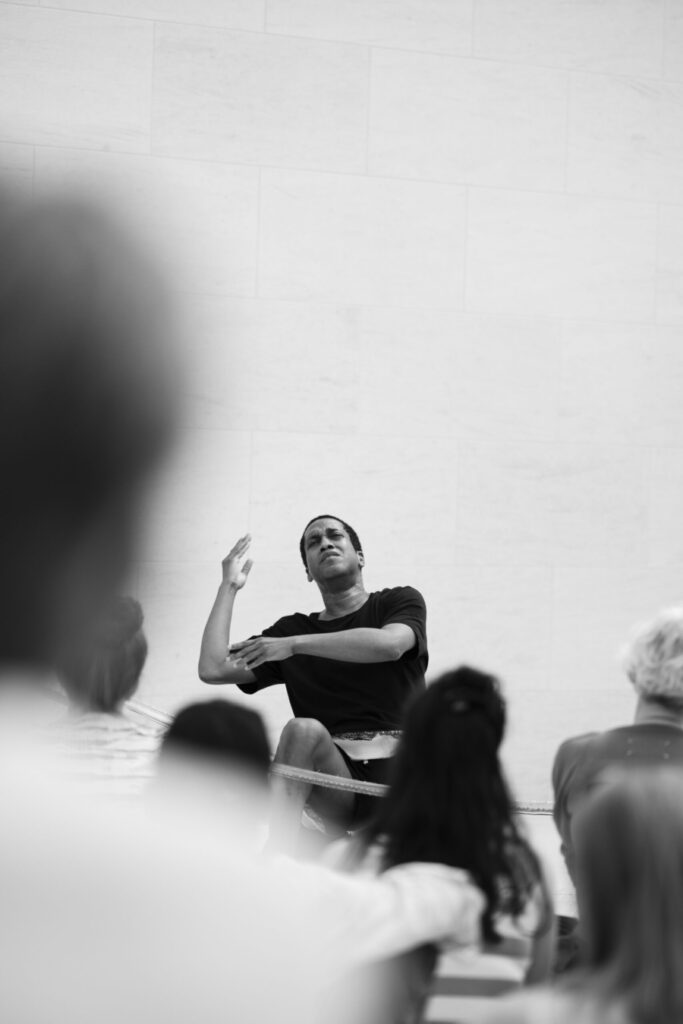 MA: Joel, how did you and Trajal start working on his performance at Mudam?
MA: Joel, how did you and Trajal start working on his performance at Mudam?
Joel Valabrega: When I started working at Mudam back in 2020, there wasn’t a performance programme, which is why they opened the position I now hold. Nevertheless the museum’s programme had included some performance–based works. One of Mudam’s highlights was in fact Trajal’s incredibile piece, The Conspiracy of Performances ; eight performances throughout different spaces of the museum. Trying to work on increasing the engagement levels of our local audience, I thought it could be helpful to bring back a renowned choreographer who had already performed here. It was indeed very successful to bring him at Mudam for a second time because our audience felt at ease and eager to come and see how his practice had developed. Trajal and I have been in conversation for a long time about this new and stunning piece, which was originally supposed to première at the 13th Gwangju Biennial (due to the pandemic, he was unable to travel and to perform). He had been working on this new piece for a very long time and was looking for the right place to perform it, a space which could emphasise the importance of intimacy. As he had already performed here and felt very comfortable in Mudam’s spaces, we both agreed on organising the premiere in Luxembourg, which was an incredibile experience. And I must say I’m extremely grateful to have had a chance to work with Trajal, he is one of the most inspiring artists and humans I have met to date.
MA: Is there a coherence between the artists in the program you curate at the museum? And what is the role of performance presented in an institution, particularly in Luxembourg?
JV: It has been a very exciting experience to build a performance programme from scratch. The specificity of Luxembourg – which somewhat lacks the dimension of neighbouring contemporary art scenes in that it only has a couple of institutions showing contemporary art, has no art school, a high percentage of the working population crossing one of three borders every day to start with – makes it so much more challenging to attract audiences to come and see performances at the museum. Even if live performance is most certainly establishing itself as one of the most promising discipline for current artistic experimentation, it is an art form which people are less familiar with, and for which programming requires thinking of another sort when imagining the responses of the audience, and their physical relationship to a work. This correspondence between the performance artist and the public also implies a certain level of vulnerability on both ends, which one learns to appreciate the more one is exposed to it. A programme therefore makes sense in that it renders this experience not just punctual, but regular.
Therefore the programme I have developed over the past two years presents a selection of artists who are seeking to redefine the boundaries between theatre, dance and performance, aiming to capture the multiple languages and forms of expression that they encompass. There are myriads of facets that this fascinating discipline offers; dance, spoken word, sonic performances unfolding within short pieces or long-term performances, with established and emerging artists, local, international etc. I have therefore invited a very diverse group who come from various disciplines and backgrounds, such as Eliane Radigue, Alexandra Bachzetsis, Nora Turato, Pauline Boudry & Renate Lorenz, Vasya Run, Nicholas Grafia, Mikolaj Sobczak, Jacopo Jenna, Darius Dolatyari-Dolatdoust, Ula Sickle, Stine Janvin, Cecilia Bengolea, Tarek Atoui and many others. So to answer your question, I think coherency is made manifest in my approach to the plurality of this discipline, which can only be made clear if one delves in the deep idiosyncrasies specific to the medium.
by Martina Alemani
edited by Simone Rossi
PANORAMA Series, August 2022
All Images:
Views of the performance by Trajal Harrell, Sister or He Buried the Body at Mudam, Luxembourg. Photo Courtesy: Eike Walkenhorst.
